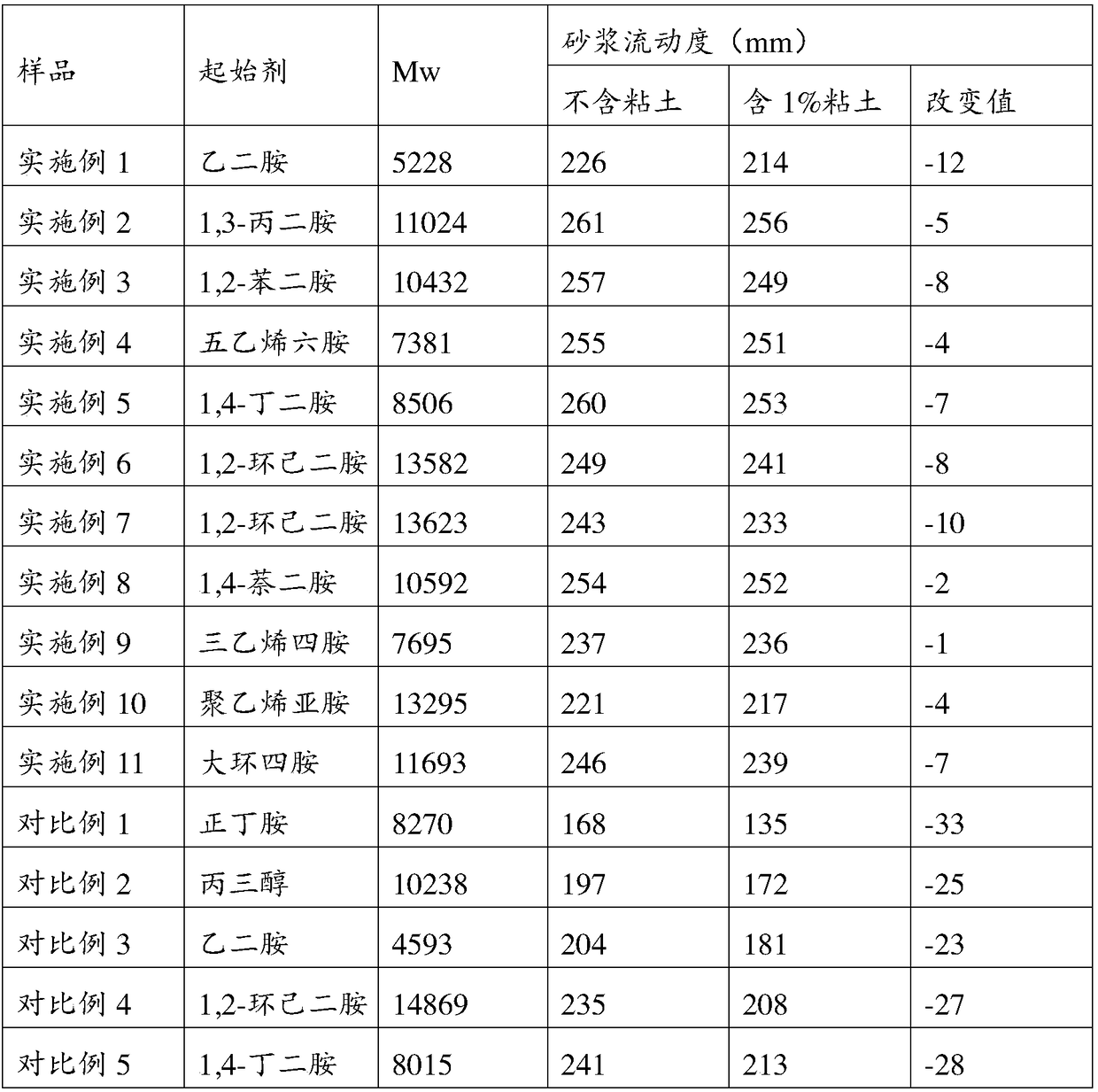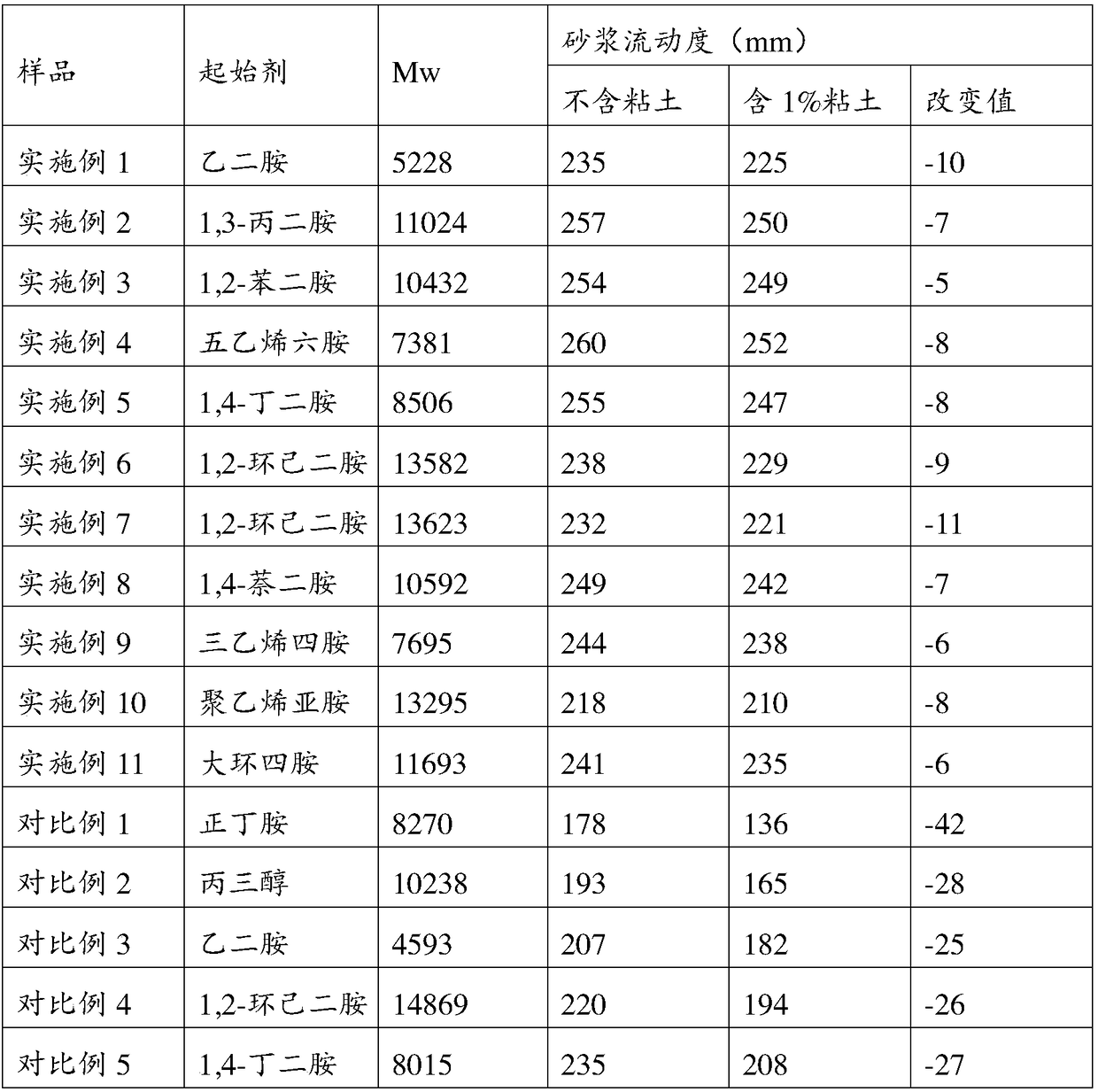Low-relative-molecular-weight anti-clay type phosphate-based superplasticizer, and preparation method and application thereof
A technology of superplasticizer and molecular weight, which is applied in the field of concrete admixture, can solve the problems that the structure and molecular weight of water reducing agent cannot be accurately controlled, the industrial conditions are harsh, and the effect is not very ideal, so as to achieve shortened reaction time, low raw material cost, The effect of reducing the negative impact
- Summary
- Abstract
- Description
- Claims
- Application Information
AI Technical Summary
Problems solved by technology
Method used
Image
Examples
Embodiment 1
[0047] Branched polyether polyamine, the synthesis initiator is ethylenediamine, the polymerization monomer is ethylene oxide, and the catalyst NaH (60wt%) addition (in terms of 100% purity) is 0.8% of the amount of ethylenediamine . Weigh 0.1 mol (6.0 g) of ethylenediamine, 11.3 mol (497.2 g) of ethylene oxide, and 32 mg of catalyst NaH (60 wt %). Add the above-mentioned initiator ethylenediamine and catalyst into a closed reaction kettle, evacuate to -0.1MPa, feed 20g of ethylene oxide, raise the temperature to 110°C to initiate the reaction and continue to feed the remaining ethylene oxide, keep the temperature for the reaction After 1 h, the volatile matter was removed under reduced pressure, and the insoluble matter was removed by filtration to obtain a branched polyether polyamine intermediate.
[0048] Branched polyether polyamine intermediate alcohol hydroxyl group (0.4mol) / phosphorylation reagent molar ratio is 1:1.05, weigh 5.1g NKC-9 and 49.6g (0.42mol) 85% phospho...
Embodiment 2
[0050] For the branched polyether polyamine, the synthetic initiator is 1,3-propylenediamine, the polymerization monomer is ethylene oxide, and the amount of catalyst sodium hydroxide added is 1.5% of the amount of 1,3-propylenediamine. Weigh 0.1 mol (7.4 g) of 1,3-propylenediamine, 24.7 mol (1086.8 g) of ethylene oxide, and 60 mg of catalyst sodium hydroxide. Add the above-mentioned initiator 1,3-propylenediamine and catalyst into a closed reaction kettle, vacuumize to -0.1MPa, feed 20g of ethylene oxide, raise the temperature to 110°C to initiate the reaction and continue to feed the remaining ethylene oxide alkane, keep warm for 3 hours, remove volatile substances under reduced pressure, and remove insoluble substances by filtration to obtain a branched polyether polyamine intermediate.
[0051] Branched polyether polyamine intermediate alcoholic hydroxyl group (0.4mol) / phosphorylation reagent molar ratio is 1:1.05, weigh 10.9g Amberlyst-15 and 49.6g (0.42mol) 85% phosphori...
Embodiment 3
[0053] For the branched polyether polyamine, the synthetic initiator is 1,2-phenylenediamine, the polymerization monomer is propylene oxide, and the amount of catalyst Na added is 1.6% of the amount of 1,2-phenylenediamine. 0.1 mol (10.8 g) of 1,2-phenylenediamine, 17.5 mol (1016.4 g) of propylene oxide, and 37 mg of catalyst Na were weighed. Add the above-mentioned initiator 1,2-phenylenediamine and the catalyst into the closed reaction kettle, evacuate to -0.1MPa, pass in 20g of propylene oxide, raise the temperature to 110°C to initiate the reaction and continue to pass in the remaining propylene oxide, Keeping the reaction for 5 hours, removing volatile substances under reduced pressure, and removing insoluble substances by filtration to obtain a branched polyether polyamine intermediate.
[0054] Branched polyether polyamine intermediate alcoholic hydroxyl group (0.4mol) / phosphorylation reagent molar ratio is 1:1.1, weigh 20.5g NKC-9 and 82.1g (0.44mol) 76% polyphosphoric...
PUM
| Property | Measurement | Unit |
|---|---|---|
| molecular weight distribution | aaaaa | aaaaa |
| molecular weight distribution | aaaaa | aaaaa |
| molecular weight distribution | aaaaa | aaaaa |
Abstract
Description
Claims
Application Information
 Login to View More
Login to View More - R&D
- Intellectual Property
- Life Sciences
- Materials
- Tech Scout
- Unparalleled Data Quality
- Higher Quality Content
- 60% Fewer Hallucinations
Browse by: Latest US Patents, China's latest patents, Technical Efficacy Thesaurus, Application Domain, Technology Topic, Popular Technical Reports.
© 2025 PatSnap. All rights reserved.Legal|Privacy policy|Modern Slavery Act Transparency Statement|Sitemap|About US| Contact US: help@patsnap.com



